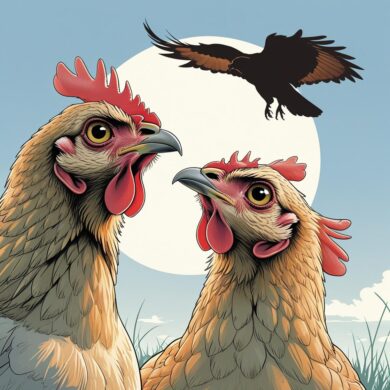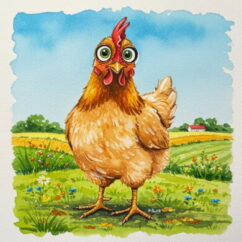Chicken Eyesight Secrets 02 : What These Birds Can See That You Can't
The anatomy behind their unique eyesight
The physical structures within chicken eyes reveal anatomical adaptations that explain their extraordinary visual capabilities. These specialized features work together to create a visual system perfectly suited to their ecological niche.
Large eyes relative to head size
Chickens possess remarkably large eyes compared to their head size. These organs occupy approximately 10% of their head mass, a stark contrast to human eyes which account for merely 1% of head mass [10][11]. This disproportionate size serves a crucial purpose—helping chickens see larger and clearer images [12].
The avian eye's prominence becomes even more striking when examining cranial volume allocation. Birds dedicate up to 50% of their cranial volume to their eyes, whereas humans allocate only about 5% [13]. This substantial investment in visual organs directly contributes to their exceptional sight capabilities. Although a chicken's eye measures only 12-1on ganglion cells compared to the estimated 700,000-1.5 million in human retinas [13]

Image: Generated with AI | 画像はイメージです

Image: Generated with AI | 画像はイメージです
Head bobbing instead of eye movement
Unlike humans, chickens cannot move their eyeballs significantly within their sockets [18]. Instead, they compensate through distinctive head movements. When chickens walk, they appear to bob their heads, but this motion serves a critical purpose. The chicken's head actually remains stationary relative to its environment while its body catches up underneath, then the head moves forward again [19]. This stabilization prevents unnecessary retinal image motion, avoiding blurry vision and maintaining clear sight [19]. Experiments even confirmed this mechanism by placing chickens on treadmills, where they didn't bob their heads at all [20].
Left eye vs. right eye specialization
Perhaps most fascinating is how chickens develop specialized eyes for different purposes. This specialization begins before hatching, when the chick positions itself with the right eye against the shell (exposed to light) and the left eye covered by its body [6]. As a result, the right eye develops near-sightedness ideal for finding food at close range, while the left eye becomes far-sighted, perfect for detecting distant predators [9]. This explains why chickens tilt their heads with their left eye toward the sky when a hawk flies overhead [6]. Research shows that the right hemisphere (connected to the left eye) handles spatial representations and fear responses, while the left hemisphere (right eye) processes detailed features of objects [17].
References
[6] - https://chooks.co.nz/blogs/news/what-can-your-chickens-see-chicken-vision?srsltid=AfmBOooanDocWOYAJpQ-NKI99OkgPXye9ZaVtUtiKrNXGtptx9FNmhnA
[9] - https://harvestsavvy.com/chickens-visual-world/
[10] - https://lafeber.com/backyard-chickens/chickens-see-differently-than-humans/?srsltid=AfmBOoqolKKe9Z0ptHGqHDl8vQqPD1KPSVWh4x0Czd_nm_9agBo9neWR
[11] - https://blog.omlet.us/2021/07/21/amazing-facts-about-chickens-eyes/
[12] - https://chooks.co.nz/blogs/news/what-can-your-chickens-see-chicken-vision?srsltid=AfmBOop7koTI2Ontjt_CtXQMmGYFA2WcI-FaDLopmZJWaDM5HmBhFsOf
[13] - https://pmc.ncbi.nlm.nih.gov/articles/PMC5653414/
[14] - https://www.jneurosci.org/content/41/23/5015
[15] - https://lafeber.com/backyard-chickens/chickens-see-differently-than-humans/?srsltid=AfmBOopmZRG06Mz7vjHw5A_6kJ0Wr7aCg6Gsn5JRoofz6LKjIinlz5g9
[16] - https://the-chicken-chick.com/chicken-anatomy-nictitating-membrane/
[17] - https://pmc.ncbi.nlm.nih.gov/articles/PMC2666078/
[18] - https://lafeber.com/backyard-chickens/chickens-see-differently-than-humans/?srsltid=AfmBOoreCE49ypUApofym9NIYweqrWfzwq2uJ5lres8jG66AHWFQLstJ
[19] - https://www.cogsci.nl/blo [20] - https://www.reddit.com/r/explainlikeimfive/comments/3gn1mq/eli5why_do_chickens_bob_their_heads_when_they_walk//


